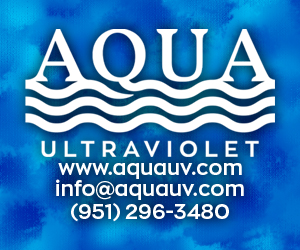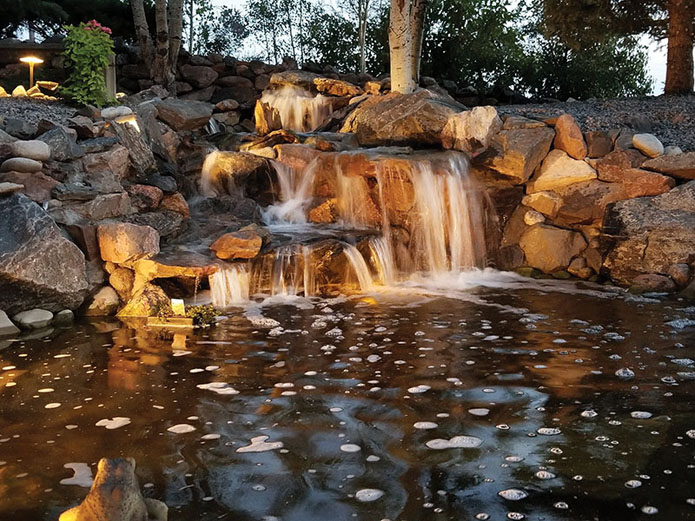
Building water feature waterfalls, while challenging, can be a very rewarding undertaking. It is crucial that they are built with both integrity and sustainability in mind.
The first step in building a waterfall is understanding the needs and wants of the client. This is the most crucial element for me. Don’t let their budget dictate the quality of products you use; instead, let the numbers dictate the actual size of the feature itself. Do they want a pondless waterfall or an open basin? What kind of maintenance, filtration, koi, recreation, and viewing points does the customer want?
The point is, there are so many kinds of water features nowadays, and it really depends on what the client’s budget will allow. This directly determines the size of the boulders you use, because rock is sold by the ton. When using large boulders, it is hard to determine the weight of each rock individually, so underestimating how much you need is a common mistake. It can be devastating after a build if you had planned on using 10,000 pounds of rock and ended up using double that amount. (But at the end of the day, it doesn’t matter so much if I spend a little more money on boulders, because I ultimately want every project to be extra special.)
After the client and I are on the same page, my next step is doing the 3-D design to understand the location, elevation and the overall waterfall concept. This helps me plan out how I want to stage the project, what the access is like and where I need to start and finish the project. This design process also helps me determine all the required materials, head heights, pipe sizing, liner or underlayment type, filters and rock orientation. Once we have it all specced out and agree on a price, the fun begins!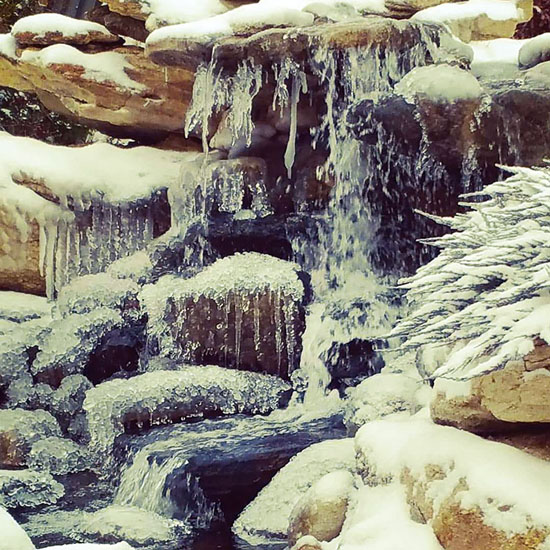
Sizing pumps, pipes and basins and setting the head height are critical when it comes to making a waterfall an overall success. I build them at maximum capacity to ensure no water loss in streams, waterfalls and basins. I tend to use more water, because with the variable speed controller on the Atlantic Water Gardens TT-Series pumps, you have total control over the water flow. Whether you want a subtle, relaxing background for a pondside chat, or you want to hear crashing from your living room 40 feet away, you can have the best of all worlds and adjust the flow as needed.
Sometimes we get to pick out the rock that we want to use, and other times we have to order a semitruck load of rock from the quarry. Harvesting rock from the existing land here in the Rocky Mountains has to be one of my all-time favorite ways to build, even though I’ve only gotten to do it a few times over eight years. This experience allowed me to handpick my boulders for the waterfalls, character rocks and even the filler rocks. Whenever I have to use a truckful of unknown boulders delivered from a quarry that I have never seen, I have to use whatever comes and just try my best to transform it into a masterpiece. This is a little more of a challenge — but a challenge I always take head on. It doesn’t matter if they give me undesirable boulders that I may not have personally selected. I take them and make them into something that I can be proud of putting the LCM Landscape & Design name behind. This craft takes a lot of time to learn.
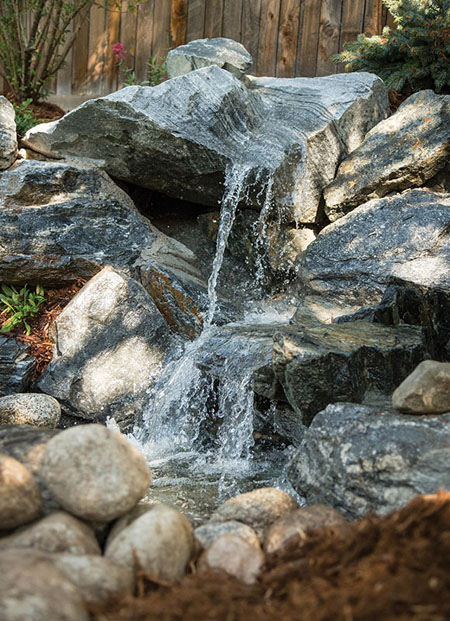 “You gotta see it, kid,” my mentor, Rick Pursell, would tell me. “Visualize where the water will be and how it will fall.”
“You gotta see it, kid,” my mentor, Rick Pursell, would tell me. “Visualize where the water will be and how it will fall.”
Always be creative when conceptualizing what the water will look like when it’s flowing. Understanding the elevation and being able to manipulate where the water will go while not allowing the water to make the decisions for you — well, it can be tough. Water has the tendency to prove you wrong again and again, so you must have the perseverance to never give up.
There are a lot of factors that come into creativity and rock selection. I am not fond of placing a bunch of small rocks on top of the liner and setting flat pieces of flagstone all by hand. Instead, I prefer to push the limits of my 9,000-pound mini excavator. I like for the rock to hang as far out as possible and make me super uncomfortable (while keeping in mind that we will ultimately cement it all in). Counterweight is also huge when it comes to setting large rocks and pushing the limits. This can be achieved by using other large boulders on the back sides of the rocks for balance. This was the style that Pursell taught me, and it’s how I build every project, big or small.
Bigger or Bust!
In my opinion, using large boulders is the only way to build. I’ll still do small projects, but they typically still involve grabbing a 2,500-pound boulder with a Toro Dingo or pushing 3-ton boulders with my mini excavator (without tipping). I can’t tell you how many times my crew has questioned my order to “strap that one — it’s going on top!” Honestly, sometimes I even wonder whether or not the machine can handle it. It might take me three hours to set one character rock, but I’m still going to get it done!
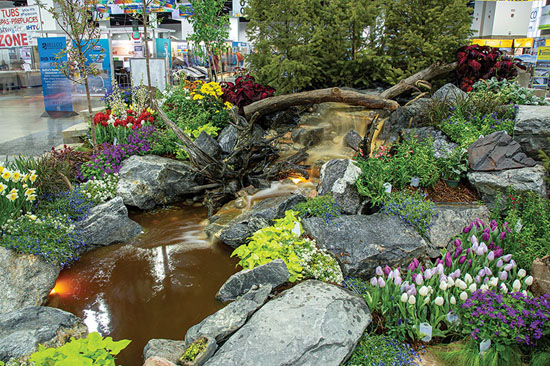
I have personally set every character stone on every waterfall we have ever built. This has allowed me to stay involved in the creative process from design to completion. After taking suggestions from my crew, I always pick out which boulder we are going to use, have the crew strap it, and then strategically place every rock. Sometimes I’ll turn it or flip it seven times if need be. There is a point of production that you must be conscious about: Don’t spend more time than you originally allotted for.
This is why I no longer offer cheap bids on jobs. If my customer wants my true abilities and creativity, I don’t need to feel rushed and have to set rocks as quickly as I can. I want to be able to go at my own pace and make sure each rock is in its perfect spot at the ideal angle. We have gotten very efficient at building waterfalls over the past eight years, but still I won’t allow myself to feel rushed or to set rocks just to set them — each one has a purpose. You have to ensure you are making the water go exactly where you want it to go, always thinking about the next set of falls. Whether it’s a massive waterfall or a stream, you have to always keep in mind what is coming next.
Design Do’s & Don’ts
Any waterfall that uniformly faces the same direction can be a design fail, in my opinion. The waterfall should have twists and turns, different elevations of fall and areas of visual interest, in addition to the sounds. Too often have I seen three falls of the same size that are all facing the same direction at the same angle on the same flat piece of flagstone with the same elevation changes.
 I try to think of every angle from which people can view the waterfalls and where the vantage points might be. People face waterfalls in different directions from different heights and at different angles. I like to ensure that everyone gets a good view of the feature, not just from the kitchen window, but from the living room, the gate, the patio, the upper deck, the bedroom window and from every possible other angle I can think of.
I try to think of every angle from which people can view the waterfalls and where the vantage points might be. People face waterfalls in different directions from different heights and at different angles. I like to ensure that everyone gets a good view of the feature, not just from the kitchen window, but from the living room, the gate, the patio, the upper deck, the bedroom window and from every possible other angle I can think of.
Adding lighting elements as the final stage can really help enhance your waterfall. Place spotlights on large character rocks, or add underwater lights to the pool. Hanging lights along the falls allows enjoyment of the feature day and night. Another thing I try to do is add driftwood pieces as natural accents to a feature. Let’s face it: The ultimate goal is to make it look like it came from the Rocky Mountains!
Remember though, proper testing and ensuring there are no leaks or unwanted evaporation takes patience and time.
In the end, it comes full circle back to the client. I want to ensure that they are happy and give them the peace of mind that their feature will last. I also make sure to educate the client about proper care and maintenance of the waterfall, leaving them with all the knowledge they need to take care of it. Having a waterfall is a truly special element in your landscape, and I always take pride in knowing that I have built something unique and of the highest quality that my client can enjoy for years to come.
